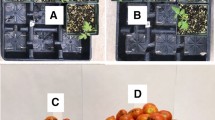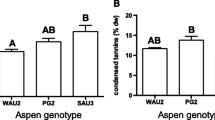Abstract
Insect-associated bacteria can mediate the intersection of insect and plant immunity. In this study, we aimed to evaluate the effects of single isolates or communities of gut-associated bacteria of Helicoverpa zea larvae on herbivore-induced defenses in tomato. We first identified bacterial isolates from the regurgitant of field-collected H. zea larvae by using a culture-dependent method and 16S rRNA gene sequencing. We identified 11 isolates belonging to the families Enterobacteriaceae, Streptococcaceae, Yersiniaceae, Erwiniaceae, and unclassified Enterobacterales. Seven different bacterial isolates, namely Enterobacteriaceae-1, Lactococcus sp., Klebsiella sp. 1, Klebsiella sp. 3, Enterobacterales, Enterobacteriaceae-2, and Pantoea sp., were selected based on their phylogenetic relationships to test their impacts on insect-induced plant defenses. We found that the laboratory population of H. zea larvae inoculated with individual isolates did not induce plant anti-herbivore defenses, whereas larvae inoculated with a bacterial community (combination of the 7 bacterial isolates) triggered increased polyphenol oxidase (PPO) activity in tomato, leading to retarded larval development. Additionally, field-collected H. zea larvae with an unaltered bacterial community in their gut stimulated higher plant defenses than the larvae with a reduced gut microbial community. In summary, our findings highlight the importance of the gut microbial community in mediating interactions between herbivores and their host plants.





Similar content being viewed by others
Data Availability
The sequence data of the 11 isolates were submitted to the NCBI database (accession number OP542430-OP542440).
Change history
03 August 2023
A Correction to this paper has been published: https://doi.org/10.1007/s00248-023-02281-z
References
Hanley ME, Lamont BB, Fairbanks MM, Rafferty CM (2007) Plant structural traits and their role in anti-herbivore defence. Perspect Plant Ecol 8:157–178. https://doi.org/10.1016/j.ppees.2007.01.001
Mitchell C, Brennan RM, Graham J, Karley AJ (2016) Plant defense against herbivorous pests: exploiting resistance and tolerance traits for sustainable crop protection. Front Plant Sci 7:1132. https://doi.org/10.3389/fpls.2016.01132
de Bobadilla MF, Bourne ME, Bloem J, Kalisvaart SN, Gort G, Dicke M, Poelman EH (2021) Insect species richness affects plant responses to multi-herbivore attack. New Phytol 231:2333–2345. https://doi.org/10.1111/nph.17228
Schuman MC, Baldwin IT (2016) The layers of plant responses to insect herbivores. Annu Rev Entomol 61:373–394. https://doi.org/10.1146/annurev-ento-010715-023851
Gershenzon J, Ullah C (2022) Plants protect themselves from herbivores by optimizing the distribution of chemical defenses. Proc Natl Acad Sci USA 119:e2120277119. https://doi.org/10.1073/pnas.2120277119
Hammer TJ, Bowers MD (2015) Gut microbes may facilitate insect herbivory of chemically defend plants. Oecologia 179:1–14. https://doi.org/10.1007/s00442-015-3327-1
Jing TZ, Qi FH, Wang ZY (2020) Most dominant roles of insect gut bacteria: digestion, detoxification, or essential nutrient provision? Microbiome 8:38. https://doi.org/10.1186/s40168-020-00823-y
Pan Q, Shikano I, Felton GW, Liu TX, Hoover K (2021) Host permissiveness to baculovirus influences time-dependent immune responses and fitness costs. Insect Sci 28:103–114. https://doi.org/10.1111/1744-7917.12755
Engel P, Moran NA (2013) The gut microbiota of insects-diversity in structure and function. FEMS Microbiol Ecol 37:699–735. https://doi.org/10.1111/1574-6976.12025
Douglas AE (2015) Multiorganismal insects: diversity and function of resident microorganisms. Annu Rev Entomol 60:17–34. https://doi.org/10.1146/annurev-ento-010814-020822
Gupta A, Nair S (2020) Dynamics of insect-microbiome interaction influence host and microbial symbiont. Front Microbiol 11:1357. https://doi.org/10.3389/fmicb.2020.01357
Tsuchida T, Koga R, Fukatsu T (2004) Host plant specialization governed by facultative symbiont. Science 303:1989. https://doi.org/10.1126/science.109461
Hosokawa T, Kikuchi Y, Shimada M, Fukatsu T (2007) Obligate symbiont involved in pest status of host insect. Proc R Soc B 274:1979–1984. https://doi.org/10.1098/rspb.2007.0620
Barr KL, Hearne LB, Briesacher S, Clark TL, Davis GE (2010) Microbial symbionts in insects influence down-regulation of defense genes in maize. PLoS One 5:e11339. https://doi.org/10.1371/journal.pone.0011339
Mason CJ, Lowe-Power TM, Rubert-Nason KF, Lindroth RL, Raffa KF (2016) Interactions between bacteria and aspen defense chemicals at the phyllosphere-herbivore interface. J Chem Ecol 42:193–201. https://doi.org/10.1007/s10886-016-0677-z
Shikano I, Rosa C, Tan CW, Felton GW (2017) Tritrophic interactions: microbe-mediated plant effects on insect herbivores. Annu Rev Phytopathol 55:313–331. https://doi.org/10.1146/annurev-phyto-080516-035319
Zhu F, Poelman EH, Dicke M (2014) Insect herbivore-associated organisms affect plant responses to herbivory. New Phytol 204:315–321. https://doi.org/10.1128/AEM.00062-07
Chung SH, Rosa C, Scully ED, Peiffer M, Tooker JF, Hoover K, Luthe DS, Felton GW (2013) Herbivore exploits orally secreted bacteria to suppress plant defenses. Proc Natl Acad Sci USA 110:15728–15733. https://doi.org/10.1073/pnas.130886711
Chung SH, Scully ED, Peiffer M, Geib SM, Rosa C, Hoover K, Felton GW (2017) Host plant species determines symbiotic bacterial community mediating suppression of plant defenses. Sci Rep 7:39690. https://doi.org/10.1038/srep39690
Sorokan AV, Burkhanova GF, Benkovskaya GV, Maksimov IV (2019) Colorado potato beetle microsymbiont Enterobacter BC-8 inhibits defense mechanisms of potato plants using crosstalk between jasmonate- and salicylate-mediated signaling pathways. Arthropod-Plant Inte 14:161–168. https://doi.org/10.1007/s11829-019-09732-w
Acevedo FE, Peiffer M, Tan CW, Stanley BA, Stanley A, Wang J, Jones AG, Hoover K, Rosa C, Luthe D, Felton GW (2017) Fall armyworm associated gut bacteria modulate plant defense responses. Mol Plant Microbe In 30:127–137. https://doi.org/10.1094/MPMI-11-16-0240-R
Wang J, Peiffer M, Hoover K, Rosa C, Zeng R, Felton GW (2017) Helicoverpa zea gut-associated bacteria indirectly induce defenses in tomato by triggering a salivary elicitor(s). New Phytol 214:1294–1306. https://doi.org/10.1111/nph.14429
Chaudhary R, Atamian HS, Shen Z, Briggs SP, Kaloshian I (2014) GroEL from the endosymbiont Buchnera aphidicola betrays the aphid by triggering plant defense. Proc Natl Acad Sci USA 111:8919–8924. https://doi.org/10.1073/pnas.1407687111
Peiffer M, Felton GW (2009) Do caterpillars secrete ‘oral secretions’? J Chem Ecol 35:326–335. https://doi.org/10.1007/s10886-009-9604-x
Bibb JL, Cook D, Catchot A, Musser F, Stewart SD, Leonard BR, Buntin GD, Kerns D, Allen TW, Gore J (2018) Impact of corn earworm (Lepidoptera: Noctuidae) on field corn (Poales: Poaceae) yield and grain quality. J Econ Entomol 111:1249–1255. https://doi.org/10.1093/jee/toy082
CABI. Helicoverpa zea (bollworm). In: Invasive species compendium. (www.cabi.org/isc, 2022)
Mason CJ (2020) Complex relationships at the intersection of insect gut microbiomes and plant defenses. J Chem Ecol 46:793–807. https://doi.org/10.1007/s10886-020-01187-1
Sugio A, Dubreuil G, Giron D, Simon JC (2015) Plant-insect interactions under bacterial influence ecological implications and underlying mechanisms. J Exp Bot 66:467–478. https://doi.org/10.1093/jxb/eru435
Voirol LRP, Frago E, Kaltenpoth M, Hilker M, Fatouros NE (2018) Bacterial symbionts in lepidoptera: their diversity, transmission, and impact on the host. Front Microbiol 9:556. https://doi.org/10.3389/fmicb.2018.0055
Ray S, Alves P, Ahmad I, Gaffoor I, Acevedo FE, Peiffer M, Jin S, Han Y, Shakeel S, Felton GW, Luthe DS (2016) Turnabout is fair play: herbivory-induced plant chitinases excreted in fall armyworm frass suppress herbivore defenses in maize. Plant Physiol 171:694–706. https://doi.org/10.1104/pp.15.01854
Groen SC, Humphrey PT, Chevasco D, Ausubel FM, Pierce NE, Whiteman NK (2016) Pseudomonas syringae enhances herbivory by suppressing the reactive oxygen burst in Arabidopsis. J Insect Physiol 84:90–102. https://doi.org/10.1016/j.jinsphys.2015.07.011
Pan Q, Shikano I, Hoover K, Liu TX, Felton GW (2019) Pathogen-mediated tritrophic interactions: baculovirus-challenged. J Chem Ecol 45:515–524. https://doi.org/10.1007/s11829-018-9634-9
Tan CW, Peiffer M, Hoover K, Rosa C, Acevedo FE, Felton GW (2018) Symbiotic polydnavirus of a parasite manipulates caterpillar and plant immunity. Proc Natl Acad Sci USA 115:5199–5204. https://doi.org/10.1073/pnas.1717934115
Tan CW, Peiffer M, Hoover K, Rosa C, Felton GW (2019) Parasitic wasp mediates plant perception of insect herbivores. J Chem Ecol 45:972–981. https://doi.org/10.1007/s10886-019-01120-1
Coolen S, Magda RM, Welte CU (2022) The secret life of insect-associated microbes and how they shape insect-plant interactions. FEMS Microbiol Ecol 98:fiac083. https://doi.org/10.1093/femsec/fiac083
Wang Q, Garrity GM, Tiedje JM, Cole JR (2007) Naïve Bayesian classifier for rapid assignment of rRNA sequences into the new bacterial taxonomy. Appl Environ Microb 73:5261–5267. https://doi.org/10.1128/AEM.00062-07
Tamura K, Stecher G, Kumar S (2021) Mega11: molecular evolutionary genetics analysis version 11. Mol Biol Evol 38:3022–3027. https://doi.org/10.1093/molbev/msab120
Pan Q, Shikano I, Hoover K, Liu TX, Felton GW (2019) Enterobacter ludwigii, isolated from the gut microbiota of Helicoverpa zea, promotes tomato plant growth and yield without compromising anti-herbivore defenses. Arthropod-Plant Inte 13:271–278. https://doi.org/10.1007/s11829-018-9634-9
Bradford MM (1976) A rapid and sensitive method for the quantitation of microgram quantities of protein utilizing the principle of protein-dye binding. Anal Biochem 72:248–254. https://doi.org/10.1006/abio.1976.9999
Eichenseer H, Mathews MC, Bi JL, Murphy JB, Felton GW (1999). Arch Insect Biochem 42:99–109. https://doi.org/10.1002/(SICI)1520-6327(199909)42:1<99::AID-ARCH10>3.0.CO;2-B
Le Chevalier F, Cascioferro A, Frigui W, Pawlik A, Boritsch EC, Bottai D, Majlessi L, Herrmann JL, Brosch R (2015) Revisiting the role of phospholipases C in virulence and the lifecycle of Mycobacterium tuberculosis. Sci Rep 5:16918. https://doi.org/10.1038/srep16918
Author information
Authors and Affiliations
Contributions
TXL, GWF, and QJP designed the experiments. QJP performed experiments, analyzed the data, and wrote the manuscript. IS analyzed the data and revised the manuscript. TXL and GWF revised the manuscript. All authors have approved the final manuscript.
Corresponding authors
Ethics declarations
Conflict of Interest
The authors declare no competing interests.
Rights and permissions
Springer Nature or its licensor (e.g. a society or other partner) holds exclusive rights to this article under a publishing agreement with the author(s) or other rightsholder(s); author self-archiving of the accepted manuscript version of this article is solely governed by the terms of such publishing agreement and applicable law.
About this article
Cite this article
Pan, Q., Shikano, I., Liu, TX. et al. Helicoverpa zea–Associated Gut Bacteria as Drivers in Shaping Plant Anti-herbivore Defense in Tomato. Microb Ecol 86, 2173–2182 (2023). https://doi.org/10.1007/s00248-023-02232-8
Received:
Accepted:
Published:
Issue Date:
DOI: https://doi.org/10.1007/s00248-023-02232-8




